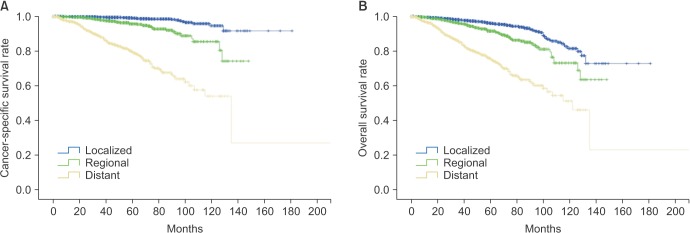Investig Clin Urol.
2017 Nov;58(6):434-439. 10.4111/icu.2017.58.6.434.
Establishment of Korean prostate cancer database by the Korean Urological Oncology Society
- Affiliations
-
- 1Department of Urology, Asan Medical Center, Ulsan University College of Medicine, Seoul, Korea.
- 2Department of Urology, Chonbuk National University Medical School, Research Institute of Clinical Medicine of Chonbuk National University-Biomedical Research Institute of Chonbuk National University Hospital, Jeonju, Korea.
- 3Department of Urology, Samsung Medical Center, Sungkyunkwan University School of Medicine, Seoul, Korea.
- 4Department of Urology, Seoul National University Hospital, Seoul National University School of Medicine, Seoul, Korea.
- 5Department of Urology, Dong-A University College of Medicine, Busan, Korea.
- 6Department of Urology, Kyungpook National University School of Medicine, Daegu, Korea.
- 7Department of Urology, GangNeung Asan Hospital, Ulsan University College of Medicine, Gangneung, Korea.
- 8Department of Urology, Konkuk University Medical Center, Konkuk University School of Medicine, Seoul, Korea. drsilent@kuh.ac.kr
- KMID: 2414771
- DOI: http://doi.org/10.4111/icu.2017.58.6.434
Abstract
- PURPOSE
Despite the necessity, to date, no detailed database of prostate cancer, especially one that includes clinicopathological data, has been created in Korea. For that reason, the Korean Urological Oncology Society (KUOS) decided to create the Korean Prostate Cancer Database (KPCD).
MATERIALS AND METHODS
The KPCD program was introduced in 2010. After considering regional distribution, a total of 20 hospitals participated in the KPCD. The Database consists of 4 domains (demographic, pretreatment, treatment, and follow-up data) and 135 variables.
RESULTS
In total, 7,608 men with prostate cancer between 2000 and 2010 were registered in the KPCD. The mean age at the time of diagnosis was 67.6±7.7 years. The mean PSA at diagnosis was 74.0±366.9 ng/mL, and the proportions of patients with Gleason scores of ≤6, 7, and 8-10 were 37.0%, 26.7%, and 34.2%, respectively. At diagnosis, 62.3% of the patients had localized tumors, 14.6% had regional, 12.8% had distant, and 10.4% cases were from unknown diseases. With regards to the initial treatment modality employed, 1.3% of patients were managed with active surveillance, 62.1% underwent surgery, 4.3% underwent radiotherapy, 27.1% had androgen deprivation therapy, and 5.2% underwent unknown therapies. The 5-year cancer-specific survival rate of patients in the KPCD was 98.6% in the localized stage, 94.8% in the regional stage, 74.7% in the distant stage, and 86.9% in the unknown stage.
CONCLUSIONS
The KUOS created a relatively successful database of patients with prostate cancer in Korea. The KPCD will continue to improve the availability of data regarding prostate cancer.
Keyword
MeSH Terms
Figure
Cited by 1 articles
-
Trends in Prostate Cancer Prevalence and Radical Prostatectomy Rate according to Age Structural Changes in South Korea between 2005 and 2015
Hyun Young Lee, Suyeon Park, Seung Whan Doo, Won Jae Yang, Yun Seob Song, Jae Heon Kim
Yonsei Med J. 2019;60(3):257-266. doi: 10.3349/ymj.2019.60.3.257.
Reference
-
1. Parkin DM, Pisani P, Ferlay J. Global cancer statistics. CA Cancer J Clin. 1999; 49:33–64. 1PMID: 10200776.
Article2. Sim HG, Cheng CW. Changing demography of prostate cancer in Asia. Eur J Cancer. 2005; 41:834–845. PMID: 15808953.
Article3. Oh CM, Won YJ, Jung KW, Kong HJ, Cho H, Lee JK, et al. Cancer Statistics in Korea: incidence, mortality, survival, and prevalence in 2013. Cancer Res Treat. 2016; 48:436–450. PMID: 26987395.
Article4. Shin HR, Won YJ, Jung KW, Kong HJ, Yim SH, Lee JK, et al. Nationwide cancer incidence in Korea, 1999~2001; first result using the national cancer incidence database. Cancer Res Treat. 2005; 37:325–331. PMID: 19956367.6. Statistics Korea [Internet]. Daejeon: Statistics Korea;2012 Mar 10. Available from: http://kostat.go.kr/portal/english/index.action.
Article7. Lubeck DP, Litwin MS, Henning JM, Stier DM, Mazonson P, Fisk R, et al. CaPSURE Research Panel. Cancer of the Prostate Strategic Urologic Research Endeavor. The CaPSURE database: a methodology for clinical practice and research in prostate cancer. Urology. 1996; 48:773–777. PMID: 8911524.
Article8. Akaza H, Usami M, Hinotsu S, Ogawa O, Kagawa S, Kitamura T, et al. Characteristics of patients with prostate cancer who have initially been treated by hormone therapy in Japan: J-CaP surveillance. Jpn J Clin Oncol. 2004; 34:329–336. PMID: 15333685.
Article9. Lee DH, Lee SH, Rha KH, Choi IY, Lee JY, Kim SW, et al. The establishment of K-CaP (the Multicenter Korean Prostate Cancer Database). Korean J Urol. 2013; 54:229–233. PMID: 23614058.10. Jung KW, Park S, Kong HJ, Won YJ, Lee JY, Seo HG, et al. Cancer statistics in Korea: incidence, mortality, survival, and prevalence in 2009. Cancer Res Treat. 2012; 44:11–24. PMID: 22500156.
Article11. Howlader N, Noone AM, Krapcho M, Neyman N, Aminou R, Waldron W, et al. SEER cancer statistics review, 1975-2009 (vintage 2009 populations). Bethesda (MD): National Cancer Institute;2012.
Article
- Full Text Links
- Actions
-
Cited
- CITED
-
- Close
- Share
- Similar articles
-
- The Establishment of K-CaP (the Multicenter Korean Prostate Cancer Database)
- Incidence of kidney, bladder, and prostate cancers in Korea: An update
- Epidemiology of Urologic Cancer in Korea: Nationwide Trends in the Last 2 Decades
- Establishment of Prospective Registry of Active Surveillance for Prostate Cancer: The Korean Urological Oncology Society Database
- The Important Role of Poly ADP-Ribose Polymerase Inhibitor in Prostate Cancer



